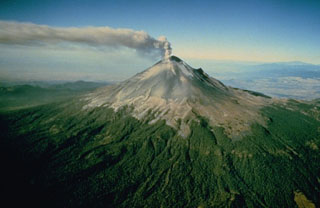Report on Popocatepetl (Mexico) — 27 November-3 December 2024
Smithsonian Institution / US Geological Survey
Weekly Volcanic Activity Report, 27 November-3 December 2024
Managing Editor: Sally Sennert.
Please cite this report as:
Global Volcanism Program, 2024. Report on Popocatepetl (Mexico) (Sennert, S, ed.). Weekly Volcanic Activity Report, 27 November-3 December 2024. Smithsonian Institution and US Geological Survey.
Popocatepetl
Mexico
19.023°N, 98.622°W; summit elev. 5393 m
All times are local (unless otherwise noted)
The Centro Nacional de Prevención de Desastres (CENAPRED) reported that eruptive activity continued at Popocatépetl during 26 November-3 December. The seismic network recorded 16-51 long-period events per day that were accompanied by steam-and-gas emissions sometimes containing minor amounts of ash. The seismic network also recorded daily tremor, sometimes characterized as low-amplitude and/or high-frequency, with periods lasting 11 minutes to as long as nearly nine hours. Notable eruptive events at 0510 and 0630 on 1 December ejected material onto the upper flanks. According to the Washington VAAC ash plumes were visible in webcam and satellite images during 27-30 November, 1 December, and 3 December rising 5.8-6.1 km (19,000-20,000 ft) a.s.l. and drifting mostly SW, W, and NW. The Alert Level remained at Yellow, Phase Two (the middle level on a three-color scale) and the public was warned to stay 12 km away from the crater.
Geological Summary. Volcán Popocatépetl, whose name is the Aztec word for smoking mountain, rises 70 km SE of Mexico City to form North America's 2nd-highest volcano. The glacier-clad stratovolcano contains a steep-walled, 400 x 600 m wide crater. The generally symmetrical volcano is modified by the sharp-peaked Ventorrillo on the NW, a remnant of an earlier volcano. At least three previous major cones were destroyed by gravitational failure during the Pleistocene, producing massive debris-avalanche deposits covering broad areas to the south. The modern volcano was constructed south of the late-Pleistocene to Holocene El Fraile cone. Three major Plinian eruptions, the most recent of which took place about 800 CE, have occurred since the mid-Holocene, accompanied by pyroclastic flows and voluminous lahars that swept basins below the volcano. Frequent historical eruptions, first recorded in Aztec codices, have occurred since Pre-Columbian time.
Sources: Centro Nacional de Prevencion de Desastres (CENAPRED), Washington Volcanic Ash Advisory Center (VAAC)

